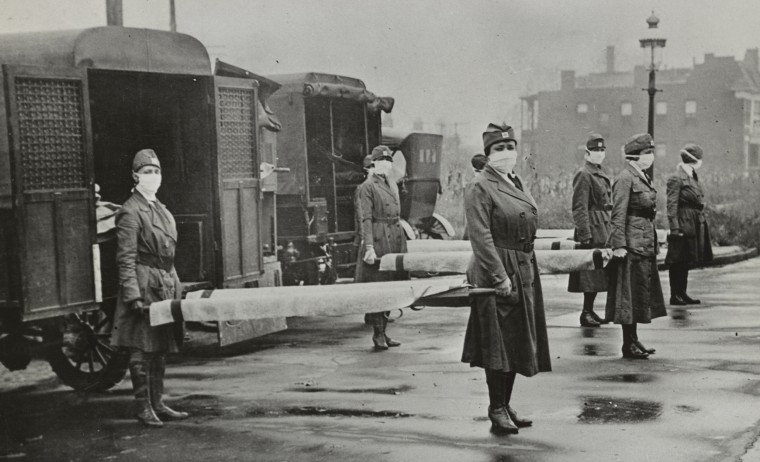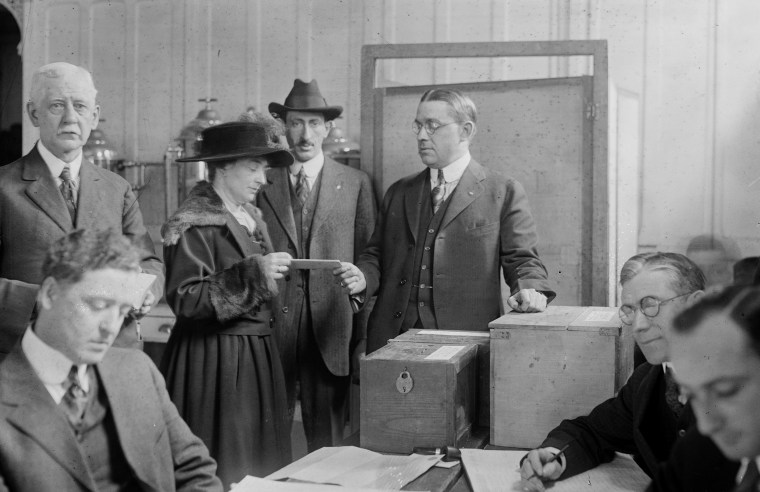President Woodrow Wilson and the Democrats were fiercely fighting to maintain control of Congress during the 1918 November midterm elections. With much of the nation hunkered down under quarantine orders with social distancing and mandatory masks, conducting an election was proving to be daunting.
But with World War I still raging on, a heightened sense of patriotism swept the country. Despite the strict orders in place, voting was considered essential at the time.
As officials scramble to safely conduct primary contests amid the coronavirus pandemic, worries mount about how the country can safely conduct a presidential election this November. How officials handled voting during the Spanish flu pandemic offers crucial lessons on balancing public health with democracy.
'First masked ballot in history'
In 1918, local officials around the country controlled elections, so how they were conducted looked different depending on where residents lived. With bans on public gatherings and schools, churches, theaters, bars and other social spots closed in many places around the country, voting was the first opportunity for many Americans to venture outdoors.
Except for soldiers, voting by mail was not a widespread option for the majority of citizens at the time. With the war as a backdrop, there was little discussion about delaying the election. Places like San Francisco instead put heavy stock in face masks to protect voters heading to the polls. Election officials urged residents to vote — and many were happy to do so at any cost.
Nancy Elworthy, 92, told the San Francisco Chronicle at the time that she was nearly blind but believed voting was "the duty" of every citizen. Another voter quoted by the paper was ill but still came out to vote.
"I must get back to bed at once," the voter said. "I really should not have come out to vote with this flu!"
The paper declared the midterms "the first masked ballot ever known in the history of America."
Voter turnout was low in the midterms overall, according to Alex Navarro, assistant director of the Center for the History of Medicine at the University of Michigan, which detailed historical accounts of the 1918-19 flu pandemic.
"Voter turnout was lower than it had been previously, by about 10 percentage points," he said, noting that while "the pandemic almost certainly had an impact ... it was also wartime. You had a lot of soldiers who were overseas or in military camps."
When voters did turn out, the scene in many places was fraught.
In Oakland, California, which saw about 1,300 deaths during the pandemic, poll workers refused to show up on Election Day either because of illness or the fear of getting infected, according to the center’s research. There may have been cause for concern: A boisterous group of about a dozen men was arrested after removing their masks to argue over the election results and fined $10 each for disobeying the city's mask ordinance.
Three people died due to the flu in Spokane, Washington, the day before Election Day, the city's worst day since the pandemic had begun. But not wanting to cancel the election, officials scrambled to make it work: They ordered inspectors to guard polling sites against overcrowding and placed some voting booths outdoors.

Currently, dozens of states have postponed their primaries or moved to mail-in or drive-by voting as the pandemic has upended the 2020 election cycle. Some states, however, have gone forward with their usual in-person voting. Wisconsin, for instance, held its April 7 primary with in-person voting after Republicans blocked efforts to move to mail-in ballots, and several cases of the coronavirus have been linked to those who went out to vote.
A second wave of the 1918 flu swept across America later in the winter, though Navarro said it’s hard to trace the spikes in major cities to Election Day specifically since the virus was spreading so rapidly and easily there anyway. In smaller cities, though, the effect was more apparent.
'Microstudies of a small community'
In rural cities around the country, the Spanish flu hit communities hard after voting in-person, said Kristin Watkins, an expert infectious disease and public health who studied the 1918 pandemic in rural Nebraska.
In Red Cloud, Nebraska — with a population of roughly 1,700, according to the 1910 U.S. Census — masks and stay-at-home orders worked well to contain the virus.
Watkins said this worked well for the city until Election Day came.
"So they lifted the quarantine for one week before elections for the candidates to come out and present," she said, "and then again for Election Day, and the next day the quarantine went back in place."
In small rural communities, where the whole town feels like neighbors, there was even more of a heightened emphasis on nationalism and patriotism, Watkins said. Going out and voting was a big point of pride. But they paid a price for it: In the week following Election Day, Watkins said, 110 people died — roughly 6.5% of the population. According to her research, the same phenomenon happened in other small communities across the Midwest.
She said it was a forewarning to election officials about voting safely.
"One of the things that is a real shame is why can't we all vote by mail? If so many states do it, and we know this saves lives and we can see it, especially in these microstudies of a small community, where you see the spikes really easily, unlike a city where you don't," she said. "Many people would have and many lives would have been spared."
"If they had the option to vote by mail, they would have," she added.
Many states are expanding vote-by-mail options this year as a way to make Election Day safer, even as President Donald Trump falsely claims that voting by mail is rife with fraud.
“Mail ballots, they cheat,” Trump said in April. "Mail ballots are a very dangerous thing for this country, because they're cheaters."
David Becker, a U.S. elections expert and executive director and founder of the nonprofit Center for Election Innovation and Research, disputed this notion, saying that mail-in voter fraud — much like in-person voter fraud — is virtually nonexistent.
Becker also noted that many states have been conducting some form of mail-in voting for years without major issues. In Colorado, which boasts nearly 3.5 million active voters, has been a vote-by-mail state since 2014 and conducts drive-thru voting.
"Despite what we’re seeing from politicians and the White House and elsewhere who are mostly concerned about who’s going to win an election," Becker said, "election officials in the state are doing what they need to do to protect voters."

